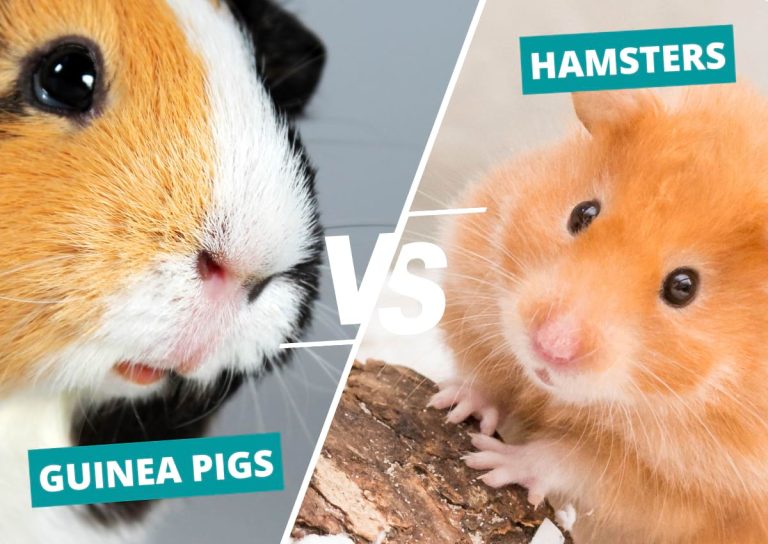How Much Does It Cost to Have a Hamster?
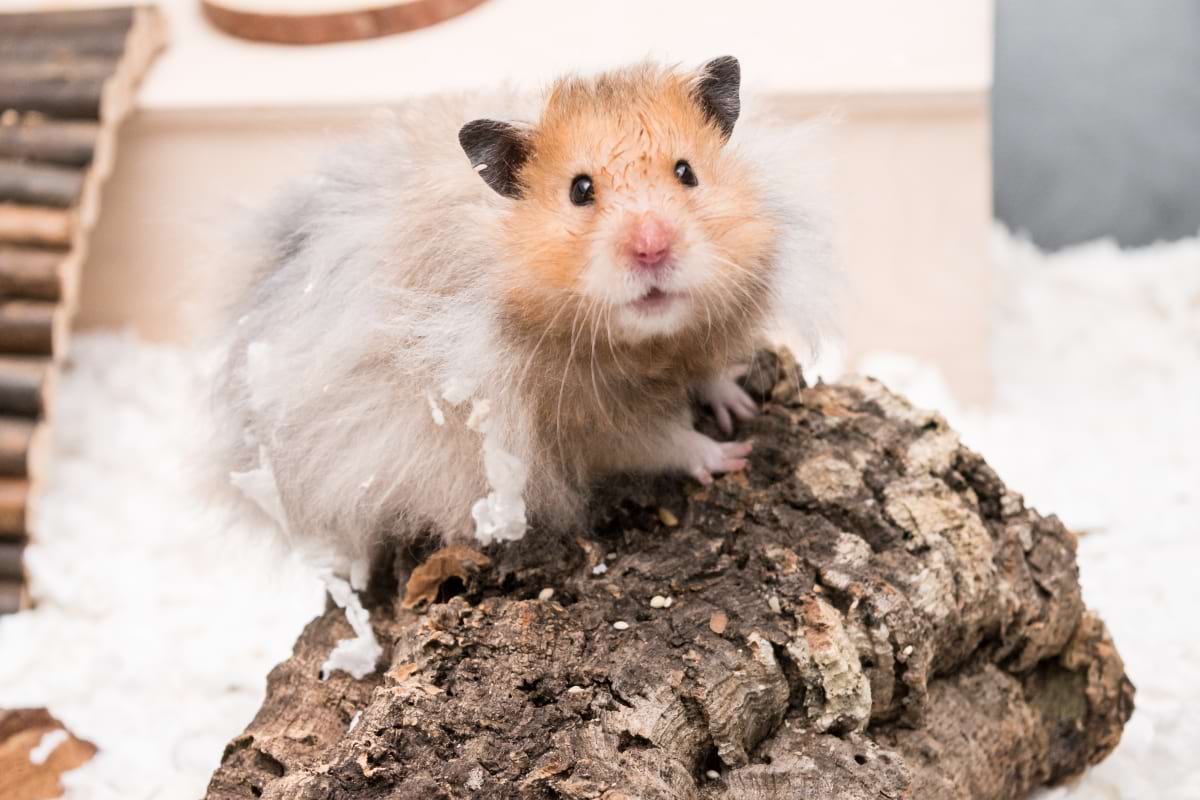
If you’re thinking of adopting a pet hamster, it’s important to know what you’re getting yourself into cost-wise.
While hamsters are not expensive pets on a monthly basis, the initial setup costs are not as low as most people expect. The costs of a cage, bedding, toys, enrichment, food and accessories quickly add up and can leave you wondering how you’ll afford to buy everything your new pet needs.
Let’s go over how much money you’ll need to cover the initial costs, as well as the costs you can expect on a monthly basis.
How Much Does It Cost to Have a Hamster
| Start-up costs | $ (approx.) |
|---|---|
| Adoption fees | $0-$50 |
| Cage | $80-$400 |
| Bedding (for a cage of 775 sq.in., depending on the type of bedding) | $30-$180 |
| Sand bath (10lb) & container | $15-$55 |
| A wheel | $20-$35 |
| Cage accessories | $80-$125 |
| A playpen | $15-$30 |
| A carrier or a small travel cage | $15-$30 |
| TOTAL START-UP COSTS (Approx.) | $255-$905 |
| Recurring costs | $ (approx.) |
|---|---|
| Food | $80-$200 per year |
| Bedding (for a cage of 775 sq.in., depending on the type of bedding) | $20-$135 per month |
| Enrichment & treats | $5-$15 per month |
| Cleaning supplies | $0-$10 per month |
| TOTAL MONTHLY RECURRING COSTS (Approx.): | $30-$175 per month |
| Other costs | $ (approx.) |
|---|---|
| Veterinary costs | $0-$500+ per year |
| Pet insurance | $0-$15 per month |
BTW you can see some recommended products in our “Idea List” on Amazon to get a sense of how much it costs.
Cost of a Hamster
When it comes to getting a pet hamster, I highly recommend checking the shelters first or seeing if anyone in your area is rehoming their pet hamster (Facebook groups, Craigslist, and other online marketplaces are great for this).
Unfortunately, buying a hamster from most pet stores promotes unethical “backyard” breeding, where hamsters are kept and bred in terrible conditions just for money. So, it’s worthwhile to check other sources first.
You might also have luck in finding ethical hamster breeders in your area. This is a bit more expensive but so worth it as you won’t be promoting unethical breeders, and your hamster is more likely to be healthy and have a good temperament.
Cost of a hamster: $0-$50
Start-up Costs
Cage
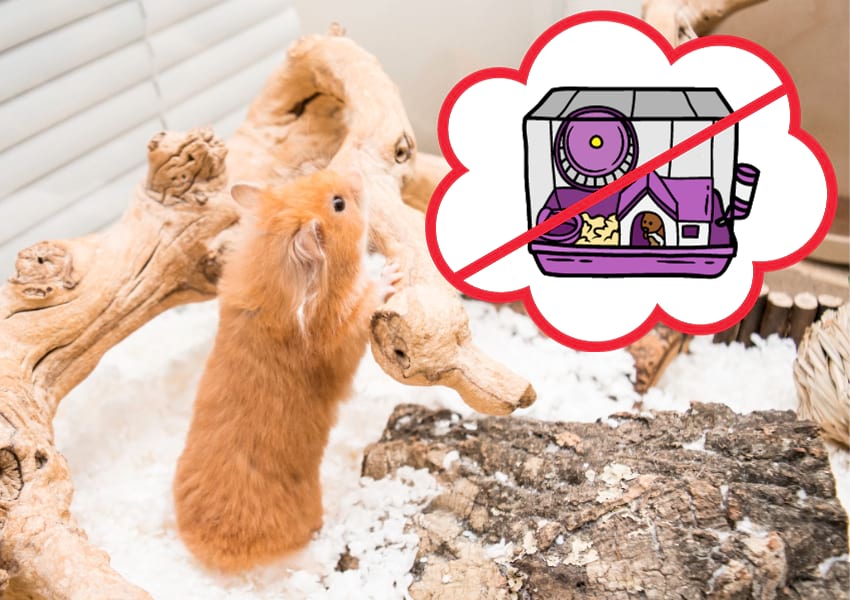
The first thing you’ll need for your hamster is a cage. The cage prices vary a lot, but you can expect to pay around a few hundred dollars.
You might’ve seen hamster cages in pet stores for around $50 or less, but those cages are way too small to house a hamster! The minimum cage size recommended by animal welfare organizations is 775 sq. in. and those cheap cages are not even close to this minimum.
Hamsters get extremely stressed living in a small cage, and it’s not rare for them to exhibit stress behaviors such as cage biting, running in circles, or trying to escape.
Costs of Different Appropriate Hamster Cages
Appropriate hamster cages include:
- Hamster cages with at least 775 sq. inches of floor space – you can see some recommended cages here
- 75-gallon aquariums or larger
- DIY cages or cabinets converted into hamster cages – for example, IKEA Detolf
The easiest solution would be to buy a spacious hamster cage, as all you have to do is set it up, and you’re done.
Niteangel makes some of the best hamster cages on the market. If you decide to go with one of their cages, you can expect to spend around $250-$300. Make sure to get size M or L, as the S size ones are under the minimum.
IKEA Detolf can also work well as a hamster cage. Since it is long but narrow, it works best for smaller (dwarf) hamster species such as Roborovski and Chinese hamsters. I got my IKEA Detolf for $85, although it seems to be more expensive nowadays. But it’s still cheaper than many actual hamster cages that provide the same floor space. Keep in mind that you’ll need to make a lid yourself.
I recommend shopping around and checking out some of the cages I listed here before making a purchase. You don’t want to make a rash decision and then realize the cage you just paid a few hundred dollars for will not work for you and your hamster!
Also, it’s a good idea to look around for second-hand hamster cages or aquariums on Craigslist or Facebook Marketplace. Often, you can find high-quality used cages for a fraction of the price.
Approx. cost of a hamster cage: $80-$400
Bedding (Substrate) & Nesting Material

Bedding is an essential part of your hamster cage setup. Digging and burrowing is a hamster’s natural behavior as they live in underground chambers in the wild.
Bedding is something you’ll need a lot of. A suitable-sized cage of 775 sq. in. requires around 150-250 liters of bedding volume just to fill it with 10 inches of bedding (depending on the type of bedding).
You can use our handy hamster bedding calculator to check how much bedding you need exactly to fill your cage properly.
Here is how many inches of bedding your hamster needs:
- 12 inches for Syrian hamsters (no less than 10 inches)
- 10 inches of bedding for Chinese hamsters and dwarfs (no less than 6 inches)
Paper bedding usually costs $15-$30 for 50L of bedding and you’ll need to multiply it x4 to x6 to cover the cage with enough bedding for burrowing. This results in the cost of $60-$180 for a minimum cage size of 775 sq.in.
Some other types of bedding such as aspen can be purchased for less, so you might be able to spend only $30 to fill the cage with bedding.
A Sand Bath
A sand bath is a relatively cheap addition to the cage, and you don’t have to change it very often unless your hamster is very messy and stinks it up. You can sift the sand every few days to get the soiled bits out and change the entire sand when you’re doing a full cage clean.
To save money on sand, you can use big bags of children’s play sand instead of the pet store sand. The children’s play sand should be heat-treated. If it’s not, you’ll need to sterilize it by baking it in the oven at 350°F (180°C) for 20-30 minutes. But be careful – hot sand is indeed very hot!
The sand will cost you around $15-$35 for a 10-pound bag, and that should last for a long time. Plus, you’ll pay additional $10-$20 for a container to keep the sand in.
A Large Wheel
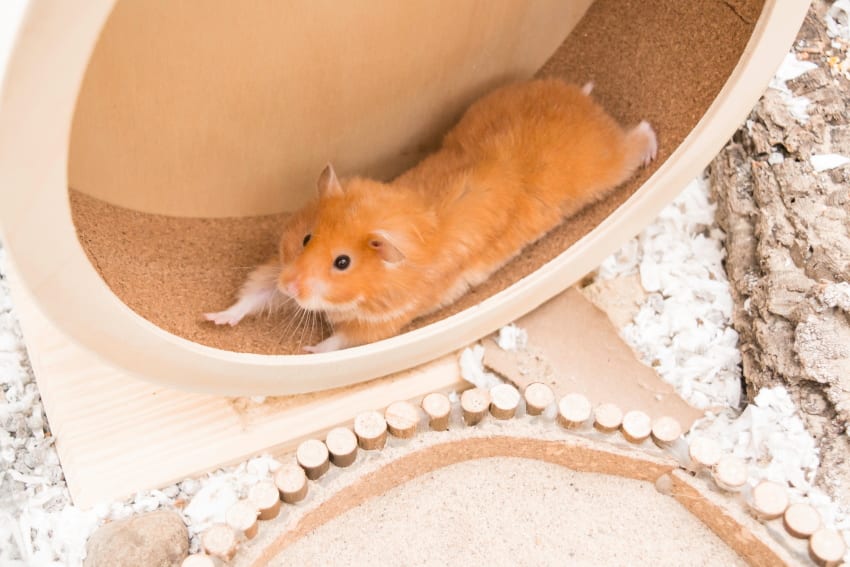
When purchasing a wheel, it’s important to get the right size. Getting one that is too small can cause injury to your hamster’s back.
The wheel should also be made of solid material, so no mesh or barred wheels which can trap your pet’s body parts and damage them. You can read more about the type of wheels that are safe for hamsters here.
Here’s how big of a wheel you need:
- 8’’ (20 cm) for dwarf species
- 10’’ (25 cm) for Chinese hamsters
- 11’’ (28 cm) for Syrian hamsters
Cost: most suitable wheels cost $20-$35. I purchased my 10-inch wheel for around $30.
Cage Accessories and Enrichment
Now that we have covered the most essential supplies, such as a cage and bedding, it’s time to decorate the cage to make it more interesting and interactive for the hamster. For this, you’ll need accessories such as:
- Cork logs – $15
- Hidey houses – $20-$35
- Wooden bridges and ladders – $10-$20
- Tunnels – $10-$25
- Platforms – $15
- Food bowl – $5
- Water bowl/bottle – $5-$10
For all of this, you’ll probably spend between $80-$125.
A Playpen
When you want to let your hammy out of the cage for some bonding and interaction time, it’s best to use a playpen to keep them contained. Being so small, your hamster could otherwise crawl up in any hole or space over ½ inch in size.
While many people use hamster balls instead, these are not safe for multiple reasons. Hamster balls don’t provide adequate ventilation; hamsters often get their toes caught in the openings, and running inside a ball can be very disorienting for them. Also, hamsters can’t just get out if they don’t want to be in there. So basically, they are forced to be inside a small plastic ball that starts spinning as soon as they move, which is very stressful for them.
For those reasons, hamsters should not spend out-of-cage time in a ball but in a playpen instead. A playpen can be enriched with a hiding place (for example, a cardboard box), foraging plants, treats, and toys to make it more interesting.
A playpen for your hamster will cost you around $15-30.
A Carrier or a Small Travel Cage
Your hamster will likely need to see a vet at some point, so having a travel cage or a carrier is a must.
If you have an old small hamster cage (after all, most of us started with those types of cages before we knew any better!), that will work great as a travel cage. If not, you can buy a new carrier for around $15-$30.
How Much Does It Cost to Take Care of a Hamster Per Month
Food
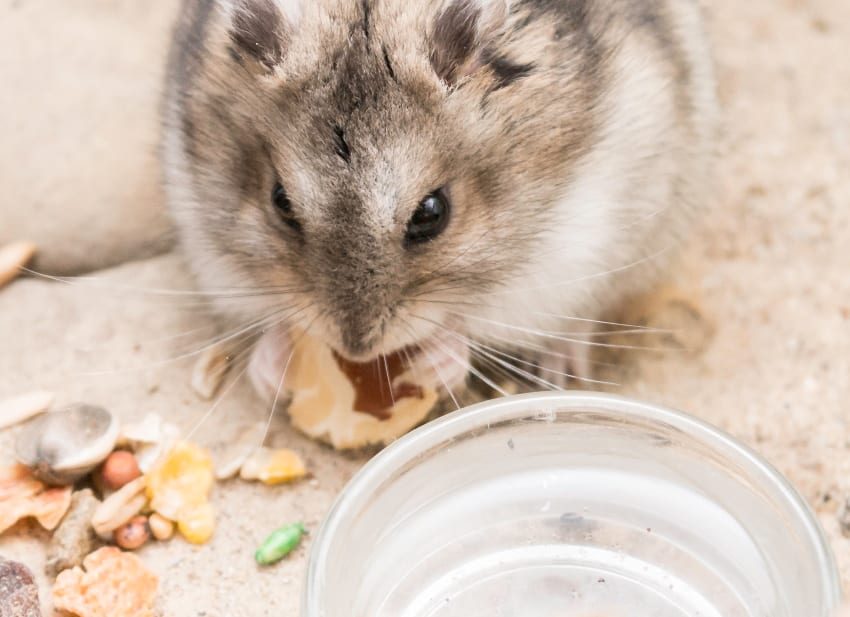
There are so many different ways (and opinions) to feed hamsters, from commercial pellets to species-specific food mixes or making your own food mix. I’m in the ‘food mixes’ team as mixes provide a variety of flavors and textures for hamsters to enjoy.
On the other hand, plain pellets are an extremely boring way to feed a hamster. Enjoying food and foraging is one of the few things that keep captive hamsters occupied, so I wouldn’t want to take that away from them.
Can you imagine eating the same exact food every day of your life? I don’t think any of us would enjoy that. A food mix is a great way to enrich the life of your pet. You can add high-quality pellets to the mix, too, but don’t make it the sole source of food.
Just 1-2 tablespoons of dry food every 2-3 days is enough for our tiny hamsters. So the hamster food should not end up costing you much as you only need small amounts.
In addition to the dry mix (and optional pellets), your hamster also needs some veggies and insects for protein (if the dry mix doesn’t include it). These amounts are also minimal, considering how small the hamsters are.
Whatever the food you choose for your hamster (or is available to you), it’ll probably be in the range of $80-$200 per year.
Bedding
Luckily for us, hamsters are not dirty or smelly animals. They don’t pee a lot and usually do their business in one dedicated place in their cage. This makes it easy to spot-clean the cage, and the bedding doesn’t need to be changed out very often. Once a month is enough, and you always need to reuse at least ¼ of the old bedding to keep some of their familiar smell in the cage.
You can expect to spend $20-$135 per month, depending on the type of bedding you use and how big the cage is.
Enrichment & Treats

Chew toys help your hamster keep their ever-growing teeth at bay. In addition to wearing down their teeth, these toys also work great as enrichment and to give your pet something fun to do.
Along with some free options such as cardboard and toilet paper rolls, the following chews and treats are popular with hamsters:
- Wooden chew sticks and blocks
- Whimzees (give occasionally as these are edible)
- Willow balls
- Dandelion and nettle roots
- Hamster-safe tree branches and twigs
- Nuts
- Herb and flower sprays
You’ll probably spend $5-$15 on treats and enrichment in a month.
Cleaning Supplies
You don’t need to spend lots of money on cleaners. I suggest using a homemade 1:1 water vinegar solution instead. This is a great natural cleaner for your hamster’s cage, and it’s highly effective for removing urine marks and other stains.
If you’d like to buy a ready-made cleaner, avoid anything that is scented since hamsters have sensitive respiratory systems, and scented products would irritate them. F10 veterinary disinfectant is a safe and effective choice.
Costs: $0-$10
Veterinary Costs
Vet costs for hamsters vary a lot from one vet to another. Treating an exotic animal, such as a hamster, can cost more than treating a cat in some places. Be prepared to pay a few hundred dollars for a consultation and treatment in some cases. And if you end up with a sickly hamster, this expanse might creep up a few times a year.
I suggest setting aside $10-20 a month in the emergency fund that you can use in case your pet needs to see a vet. Having pet insurance can also help you pay the bills.
Approx. costs of vet treatment: $0-$500 a year
Final Thoughts on Hamster Costs
This list pretty much covers all the expenses you can expect as a hamster owner. There might be a few surprises along the way such as when something breaks down, so be prepared for those situations as well.
Overall, hamsters are not extremely expensive, especially compared to pets such as dogs, but they do require substantial initial costs.
Getting a large cage, plenty of bedding for burrowing, and everything else to properly house your hamster can add up and quickly get more expensive than you hoped – especially with the inflation and skyrocketing prices. Make sure to calculate how much money you have to invest in a pet before adopting one.






